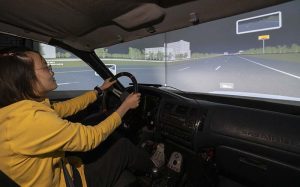June 06, 2022

Erika Zhou is “driving” 50 in a 60-mile-per-hour zone. When she approaches road work, her speed drops to about 15 below the posted limit. A few days later, Stuart Aldrich speeds down the same stretch of interstate, slowing slightly within the work zone.
Here, there’s no right or wrong way to drive. Welcome to the ZouSim Lab at Mizzou Engineering, where highways and traffic come to life in a virtual setting. The lab has a driving simulator built around the half cab of a Toyota Corolla. From the driver’s seat, study participants can see and navigate a virtual roadway on a three-screen panel around them. Just as on a real highway, participants pass buildings, trees, billboards, road signs and other vehicles.
The MU ZouSim Lab opened 10 years ago, making it one of the first of its kind in the Midwest, said Carlos Sun, professor of civil engineering and the lab’s director. In addition to the car, the lab is equipped with a bicycle simulator with electronic output for steering, speed and braking; a wheelchair simulator; a walking simulator with wearable sensors; a trucking simulator; and a e-scooter simulator. All these different transportation modes can be networked together in a virtual world.
In the recent study, Sun and his team are investigating what types of speed counter measures are most effective when it comes to slowing traffic in work zones. Zhou and Aldrich are two of dozens of participants asked to take the wheel of the Corolla and steer, speed and brake just as they would do in their own vehicle. Once they approach the virtual work zone, participants encounter a digital sign displaying their speed, a similar sign that flashes to indicate speeding, a parked police car with flashing lights and a police car that has pulled over another vehicle. Researchers are evaluating how motorists respond to each.
“Our hope is that people just drive as they normally would so we get a mix of driver behavior,” Sun said. “Some are more aggressive, and others are more defensive drivers. We want to replicate the general population and have a sampling of different driving styles.”

In addition to speed, Sun and his team also capture information about the driver, including monitoring blood pressure and sweat to determine how anxious someone is in a stressful driving situation. Eye movements are also tracked, indicating whether a motorist notices a road sign and how long they look at it.
This particular study is a collaboration with the Missouri Department of Transportation. Sun also works with local and national partners, including a study on wheelchair navigation in airports for the Federal Aviation Administration. He also recently released findings of how drivers react when they encountered driverless truck platoons for the Federal Highway Administration.
While Sun’s work is important for agencies to better understand how people navigate their settings, it also gives students the opportunity to experience traffic studies in a safe setting.
“The technology is exciting,” Sun said. “We can see how people respond to specific situations and interact with pedestrians, bicycles, trucks and other vehicles. It provides a great opportunity for students to observe real-world transportation in a safe and comfortable environment.”
Other faculty members involved with the ZouSim lab include Professor Praveen Edara, chair of civil and environmental engineering, Research Engineer Henry Brown, Postdoctoral Fellow Zhu Qing, and Assistant Professor Yaw Adu-Gyamfi.
Use state-of-the-art equipment to study engineering. Learn more about the ZouSim Lab at Mizzou!